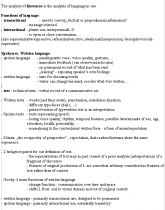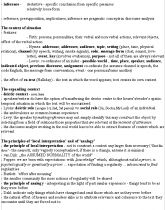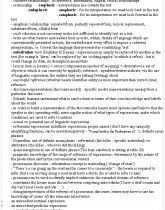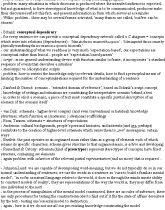Hledej
Zobraz:
Univerzity
Kategorie
Rozšířené vyhledávání
12 663
projektů
G. Brown, G. Yule: Discourse Analysis
| Přípona .doc |
Typ poznámky |
Stažené 0 x |
| Velikost 0,1 MB |
Jazyk anglický |
ID projektu 2467 |
| Poslední úprava 06.12.2013 |
Zobrazeno 1 598 x |
Autor: eliskabila |
 Sdílej na Facebooku
Sdílej na Facebooku |
||
| Detaily projektu | ||
- Cena:
2 Kreditů - kvalita:
79,6% -
Stáhni
- Přidej na srovnání
- Univerzita:Univerzita Karlova v Praze
- Fakulta:Filozofická fakulta
- Kategorie:Jazyky » Angličtina
- Předmět:Text Analysis in Translation
- Studijní obor:-
- Ročník:-
- Formát:MS Office Word (.doc)
- Rozsah A4:10 stran
G. Brown, G. Yule: Discourse Analysis
© Cambridge University Press 1983
1. Introduction: linguistic forms and functions
The analysis of discourse is the analysis of language in use.
Functions of language:
- transactional - used to convey „factual or propositional information“
- message oriented
- interactional - phatic use, interpersonalL.D.
- to open or close conversation, ...
(also representative/expressive, referential/emotive, ideational/interpersonal, descriptive/social-expressive)
Spoken vs. Written language:
- spoken language - paralinguistic cues - voice quality, gestures, ...
- immediate feedback (can observe interlocutor)
- no permanent record of what has been said
- „leaking“ - exposing speaker’s own feelings
- written language - time for choosing words
- writer can change his mind, reorder what was written, ...
- text - technical term - verbal record of a communicative act
- Written texts - words (and their order), punctuation, sometimes lineation
- different type-faces (italic, ...)
- printed version of typewritten text is an interpretation
- Spoken texts - texts representing speech
- losing voice quality, rhythm, temporal features, possible determinants of sex, age, education, health, personality, ...
- normalising to the conventional written form - a form of misinterpretation
- Schutz: „the reciprocity of perspective“ - expectation, that readers/listeners share the same experience.
- 2 hedges required for our definition of text:
- the representation of text may in part consist of a prior analysis (interpretation) of a fragment of discourse.
- features of original production of L are somewhat arbitrary considered as features of text rather than of context
- Goody: 2 main functions of written language:
- storage function - communication over time and space
- shifts L from oral to visual domain and out of original context
© Cambridge University Press 1983
1. Introduction: linguistic forms and functions
The analysis of discourse is the analysis of language in use.
Functions of language:
- transactional - used to convey „factual or propositional information“
- message oriented
- interactional - phatic use, interpersonalL.D.
- to open or close conversation, ...
(also representative/expressive, referential/emotive, ideational/interpersonal, descriptive/social-expressive)
Spoken vs. Written language:
- spoken language - paralinguistic cues - voice quality, gestures, ...
- immediate feedback (can observe interlocutor)
- no permanent record of what has been said
- „leaking“ - exposing speaker’s own feelings
- written language - time for choosing words
- writer can change his mind, reorder what was written, ...
- text - technical term - verbal record of a communicative act
- Written texts - words (and their order), punctuation, sometimes lineation
- different type-faces (italic, ...)
- printed version of typewritten text is an interpretation
- Spoken texts - texts representing speech
- losing voice quality, rhythm, temporal features, possible determinants of sex, age, education, health, personality, ...
- normalising to the conventional written form - a form of misinterpretation
- Schutz: „the reciprocity of perspective“ - expectation, that readers/listeners share the same experience.
- 2 hedges required for our definition of text:
- the representation of text may in part consist of a prior analysis (interpretation) of a fragment of discourse.
- features of original production of L are somewhat arbitrary considered as features of text rather than of context
- Goody: 2 main functions of written language:
- storage function - communication over time and space
- shifts L from oral to visual domain and out of original context
Klíčová slova:
sentence
pragmaties
context
staging
discourse
interpretation
Obsah:
- 1. Introduction: linguistic forms and functions
2. The role of context in interpretation
3. Topic and the representation of discourse content
4 ‘Staging’ and the representation of discourse structure
5. Information structure
6. The nature of reference in text and in discourse
7. Coherence in the interpretation of discourse



